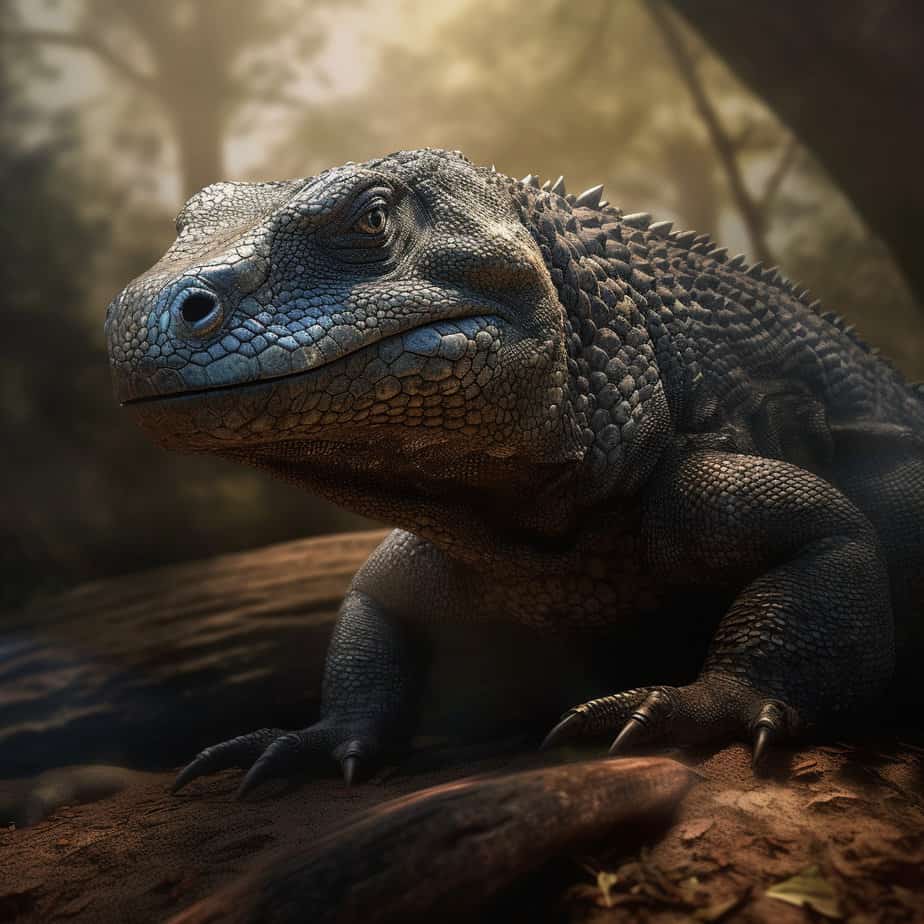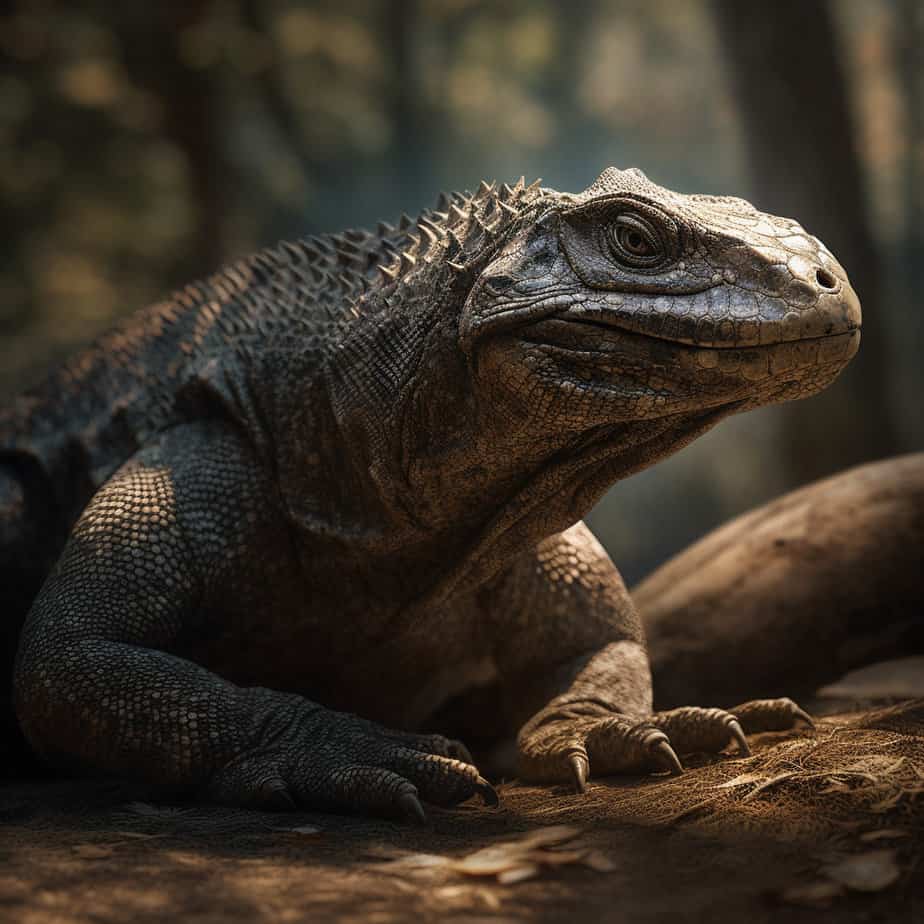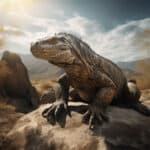The Komodo dragon, scientifically known as Varanus komodoensis, is a fascinating and formidable creature that has captured the imagination of people around the world. This large lizard, native to the Indonesian islands of Komodo, Rinca, Flores, Gili Motang, and Padar, is renowned for its impressive size and fearsome reputation as a predator. One aspect of the Komodo dragon’s life that often sparks curiosity is its lifespan. In this article, we will delve into the details of the Komodo dragon’s lifespan, exploring how long these remarkable creatures typically live and the factors that influence their longevity. So, let’s embark on a journey to uncover the secrets of the Komodo dragon’s lifespan.
Key Takeaways
- The average lifespan of a Komodo dragon is around 30 years in the wild.
- In captivity, Komodo dragons can live up to 50 years or more.
- Factors such as habitat, diet, and overall health can influence the lifespan of Komodo dragons.
- Komodo dragons are the largest lizards in the world and are native to Indonesia.
Understanding Komodo Dragons: An Overview

A. The Unique Nature of Komodo Dragons
Komodo dragons, scientifically known as Varanus komodoensis, are fascinating creatures that capture the imagination with their size, strength, and ancient lineage. These reptiles are native to the Indonesian islands of Komodo, Rinca, Flores, Gili Motang, and Padar. They belong to the monitor lizard family and are the largest living lizards on Earth.
1. Physical Characteristics
Komodo dragons have a unique set of physical characteristics that set them apart from other reptiles. They can grow up to 10 feet in length and weigh over 150 pounds, making them formidable predators. Their muscular bodies are covered in rough, scaly skin, which provides protection from their harsh environment. Their long, forked tongues help them detect prey and sense their surroundings.
2. Hunting and Feeding Habits
Komodo dragons are carnivorous predators, and their diet mainly consists of carrion, deer, pigs, and smaller reptiles. They have a keen sense of smell and can detect the scent of a dead or injured animal from miles away. Despite their massive size, they are surprisingly agile and can move quickly when hunting. They use their sharp, serrated teeth to tear apart their prey and have a unique venomous bite that aids in subduing their victims.
3. Reproduction and Nesting
Komodo dragons reach sexual maturity at around 8 to 9 years of age. During the breeding season, which typically occurs between May and August, males engage in intense combat to win the right to mate with females. Females lay their eggs in nests they dig in the ground, and the eggs incubate for approximately 7 to 8 months. Once hatched, the young Komodo dragons are left to fend for themselves.
B. Komodo Dragons: The Largest Living Lizards
Komodo dragons hold the title for being the largest living lizards in the world. Their impressive size and strength make them apex predators in their natural habitat. Let’s delve deeper into what makes these creatures so remarkable.
1. Size and Weight
As mentioned earlier, Komodo dragons can grow up to 10 feet in length and weigh over 150 pounds. This immense size allows them to overpower their prey and defend their territory against other predators. They have long, muscular tails that help them maintain balance and agility while on the move.
2. Adaptations for Survival
Komodo dragons have evolved several adaptations that enable them to survive in their harsh environment. Their strong limbs and sharp claws aid in climbing trees and digging burrows. They have a powerful bite force, capable of crushing bones, which helps them consume large prey. Additionally, their ability to swim allows them to traverse between islands in search of food and mates.
3. Lifespan and Threats
The lifespan of Komodo dragons is still a subject of research, but it is estimated that they can live up to 30 years in the wild. However, in captivity, they have been known to live longer, with some individuals reaching their 40s. Despite their impressive size and strength, Komodo dragons face several threats to their survival, including habitat loss, poaching, and climate change.
In conclusion, Komodo dragons are truly remarkable creatures. Their unique nature, impressive size, and adaptations for survival make them a subject of fascination for researchers and wildlife enthusiasts alike. Understanding their biology and behavior is crucial for their conservation and ensuring their continued existence in the wild.
The Life Cycle of a Komodo Dragon

A. Birth and Early Life
When it comes to the life cycle of a Komodo dragon, it all begins with their birth and early life. Komodo dragons, scientifically known as Varanus komodoensis, are the largest lizards on Earth. These fascinating creatures are native to the Indonesian islands of Komodo, Rinca, Flores, Gili Motang, and Padar.
-
Hatching: Female Komodo dragons lay their eggs in nests they dig in the ground. These nests provide a safe and warm environment for the eggs to develop. After an incubation period of around 7 to 8 months, the baby Komodo dragons, known as hatchlings, emerge from their eggs.
-
Vulnerable Hatchlings: At birth, Komodo dragons are relatively small, measuring around 16 to 20 inches in length and weighing just a few ounces. They are extremely vulnerable to predators during this stage of their life. To increase their chances of survival, hatchlings often climb trees and stay there until they are large enough to defend themselves.
-
Cannibalistic Tendencies: Surprisingly, one of the biggest threats to hatchlings is their own kind. Adult Komodo dragons have been known to prey on the young, making cannibalism a significant factor in the early life of these lizards.
B. Adolescence and Learning to Survive
As Komodo dragons grow, they enter a crucial stage in their life cycle – adolescence. During this period, they learn essential skills that will help them survive in their harsh environment.
-
Feeding Habits: Young Komodo dragons start off by feeding on insects, small reptiles, and birds. As they grow, their diet expands to include larger prey such as deer, pigs, and even water buffalo. They have a unique hunting technique where they ambush their prey and deliver a venomous bite. The venom, combined with the bacteria in their saliva, weakens their victims, making it easier for the Komodo dragon to overpower them.
-
Socialization: Komodo dragons are solitary creatures, but during adolescence, they may interact with other individuals. These interactions are often aggressive and involve dominance displays, fighting, and territorial disputes. Through these interactions, young Komodo dragons learn important social skills and establish their place in the hierarchy.
-
Growth and Development: During adolescence, Komodo dragons experience rapid growth. They can gain up to 10 pounds per month and reach lengths of 6 to 8 feet within a few years. This growth spurt is crucial for their survival, as it allows them to become more efficient hunters and better defend themselves against predators.
C. Adulthood: The Prime of Life
Once Komodo dragons reach adulthood, they enter the prime of their life. This stage is characterized by their ability to reproduce and establish their dominance in the ecosystem.
-
Reproduction: Female Komodo dragons reach sexual maturity at around 8 to 9 years of age, while males mature slightly earlier at around 5 to 6 years. During the mating season, which occurs between May and August, males compete for the attention of females. Dominant males engage in fierce battles, using their powerful tails and sharp claws to establish dominance and secure mating rights.
-
Nesting and Parenting: After mating, female Komodo dragons lay their eggs in nests they dig in the ground. These nests are carefully constructed to provide optimal conditions for the eggs to develop. The female guards the nest until the eggs hatch, which takes approximately 7 to 8 months. Once the hatchlings emerge, they are left to fend for themselves.
-
Longevity and Survival: The average lifespan of a Komodo dragon in the wild is estimated to be around 30 years. However, in captivity, they can live up to 50 years or more. Various factors, including habitat loss, poaching, and climate change, pose threats to their survival. Conservation efforts are crucial to ensure the long-term survival of these magnificent creatures.
In conclusion, the life cycle of a Komodo dragon is a fascinating journey from birth to adulthood. From vulnerable hatchlings to dominant adults, these lizards face numerous challenges and learn vital skills along the way. Understanding their life cycle is essential for conservation efforts and ensuring the continued existence of these remarkable creatures.
Factors Influencing the Lifespan of Komodo Dragons
Komodo dragons, the largest lizards on Earth, have captivated the imagination of people around the world. These fascinating creatures are native to the Indonesian islands of Komodo, Rinca, Flores, Gili Motang, and Padar. While they are known for their impressive size and fearsome reputation as apex predators, their lifespan is also a subject of interest. Several factors play a role in determining the lifespan of Komodo dragons, including genetic factors, diet, environmental conditions, and the presence of predators and competition.
A. Genetic Factors and Lifespan
Genetics plays a significant role in determining the lifespan of Komodo dragons. Like all living organisms, the genetic makeup of these reptiles influences their overall health and longevity. While there is limited research on the specific genes that contribute to their lifespan, it is believed that genetic factors play a crucial role in determining how long these creatures live.
Just like humans, Komodo dragons can inherit certain genetic traits that may affect their lifespan. Some individuals may be more prone to certain diseases or health conditions, while others may possess genetic variations that enhance their overall health and resilience. These genetic factors can influence the lifespan of Komodo dragons, making some individuals more likely to live longer than others.
B. The Impact of Diet on Lifespan
The diet of Komodo dragons also plays a significant role in their lifespan. These reptiles are carnivorous and primarily feed on a variety of prey, including deer, pigs, water buffalo, and smaller reptiles. Their diet consists mainly of carrion, but they are also skilled hunters.
A well-balanced diet is crucial for the overall health and longevity of Komodo dragons. A diet rich in nutrients ensures that they receive the necessary vitamins, minerals, and proteins to thrive. Inadequate nutrition can lead to health issues and a shortened lifespan. Conversely, a diet that meets their nutritional needs can contribute to their overall well-being and increase their chances of living a longer life.
C. Environmental Factors and Lifespan
The environment in which Komodo dragons live also plays a significant role in their lifespan. These reptiles inhabit a range of habitats, including savannas, forests, and grasslands. The specific environmental conditions in these habitats can impact their overall health and longevity.
Temperature, humidity, and access to water are crucial environmental factors that affect the lifespan of Komodo dragons. These reptiles are ectothermic, meaning their body temperature is regulated by their environment. Extreme temperatures or prolonged periods of drought can be detrimental to their health and survival. Similarly, a lack of access to water can lead to dehydration, which can have severe consequences for their lifespan.
D. The Role of Predation and Competition
Predation and competition also play a role in determining the lifespan of Komodo dragons. As apex predators, they have few natural predators in their native habitats. However, young Komodo dragons are vulnerable to predation by larger individuals of their own species and other predators. This predation can significantly impact their survival and lifespan.
Competition for resources, such as food and territory, can also influence the lifespan of Komodo dragons. In areas with a high population density, competition for limited resources may be intense, leading to increased stress and reduced lifespan. Conversely, in areas with abundant resources and less competition, Komodo dragons may have a higher chance of living longer.
In conclusion, the lifespan of Komodo dragons is influenced by a variety of factors, including genetic factors, diet, environmental conditions, and the presence of predators and competition. While genetic factors and diet contribute to their overall health and resilience, environmental conditions and the presence of predators and competition can impact their survival and longevity. Understanding these factors is crucial for the conservation and management of these remarkable reptiles.
The Average Lifespan of Komodo Dragons
Komodo dragons, the largest lizards on Earth, have a fascinating lifespan that varies depending on their environment. In the wild, these majestic creatures face numerous challenges that can impact their longevity. On the other hand, those kept in captivity often enjoy a longer lifespan due to the controlled conditions and specialized care they receive.
A. Lifespan in the Wild
In their natural habitat, Komodo dragons have an average lifespan of around 20 to 30 years. However, some individuals have been known to live up to 50 years or more. The harsh conditions of their environment, coupled with various factors, contribute to the relatively shorter lifespan of these remarkable reptiles.
-
Predators and Threats: Komodo dragons face numerous threats in the wild, including predation by other animals. While they are apex predators themselves, young Komodo dragons are vulnerable to attacks from larger individuals and even cannibalism. Additionally, habitat loss and human activities pose significant risks to their survival.
-
Disease and Injuries: Like any other living creature, Komodo dragons are susceptible to diseases and injuries. In the wild, they may contract infections or sustain injuries during fights with other dragons or while hunting. These health issues can significantly impact their lifespan.
-
Limited Food Resources: Komodo dragons primarily feed on carrion, but they are also skilled hunters. However, finding enough food to sustain their large bodies can be challenging. Competition for resources and fluctuations in prey availability can affect their overall health and lifespan.
B. Lifespan in Captivity
Komodo dragons kept in captivity generally have a longer lifespan compared to their wild counterparts. Under the care of experienced zookeepers and veterinarians, these magnificent creatures can live well into their 40s and even reach their 50s. Some individuals have even surpassed the age of 60.
-
Specialized Care: In captivity, Komodo dragons receive specialized care tailored to their specific needs. They are provided with a controlled environment that mimics their natural habitat, ensuring optimal conditions for their growth and development. Regular veterinary check-ups and a balanced diet contribute to their overall well-being and longevity.
-
Protection from Predators and Diseases: Captive Komodo dragons are protected from natural predators and have a reduced risk of contracting diseases. This significantly improves their chances of living a longer and healthier life.
-
Conservation Efforts: Many zoos and conservation organizations play a crucial role in the preservation of Komodo dragons. By providing a safe and protected environment, these institutions contribute to the longevity of the species as a whole. Through research and breeding programs, they aim to better understand the aging process and improve the overall health of these magnificent creatures.
In conclusion, while Komodo dragons in the wild face numerous challenges that impact their lifespan, those kept in captivity enjoy a longer and more protected life. Understanding the factors that influence their longevity is essential for conservation efforts and ensuring the survival of these incredible reptiles for future generations to admire.
Threats to the Lifespan of Komodo Dragons
A. Human Interference and Its Consequences
Komodo dragons, the largest lizards on Earth, face numerous threats to their lifespan, many of which are caused by human interference. As human activity continues to encroach upon their natural habitat, these magnificent creatures are increasingly at risk. Let’s explore some of the ways in which human actions impact the lifespan of Komodo dragons.
-
Habitat Destruction: The rapid expansion of human settlements, agriculture, and infrastructure development has led to the destruction of the Komodo dragon’s natural habitat. Deforestation and land conversion not only reduce the available space for these reptiles but also disrupt their food sources and nesting sites.
-
Poaching and Illegal Wildlife Trade: Komodo dragons are highly sought after in the illegal wildlife trade due to their unique appearance and rarity. Poachers capture these reptiles for their skins, which are used in traditional medicine and as luxury fashion items. The illegal trade not only reduces the population of Komodo dragons but also disrupts their natural breeding patterns.
-
Tourism Impact: The increasing popularity of Komodo National Park as a tourist destination has both positive and negative consequences for the lifespan of Komodo dragons. While tourism provides economic benefits for the local communities, it also brings potential threats to the dragons. Unregulated tourism can lead to habitat degradation, disturbance of nesting sites, and the introduction of invasive species.
B. Climate Change and Its Impact
Climate change is another significant threat to the lifespan of Komodo dragons. These reptiles are highly adapted to their specific environment, and even small changes in temperature and weather patterns can have severe consequences.
-
Rising Temperatures: As global temperatures continue to rise, Komodo dragons face challenges in regulating their body temperature. They rely on specific microhabitats within their range to thermoregulate, and any disruption to these habitats can lead to overheating or inadequate warmth for their survival.
-
Altered Rainfall Patterns: Changes in rainfall patterns can affect the availability of water sources for Komodo dragons. Prolonged droughts can lead to water scarcity, making it difficult for these reptiles to find sufficient hydration. This can weaken their immune systems and make them more susceptible to diseases.
-
Sea Level Rise: Komodo dragons inhabit a range of islands, and as sea levels rise, their habitats are at risk of being submerged. This not only reduces the available land for the dragons but also increases the chances of saltwater intrusion into freshwater sources, further impacting their survival.
C. Disease and Health Challenges
Komodo dragons face various disease and health challenges that can significantly impact their lifespan. These reptiles are susceptible to both infectious and non-infectious diseases, which can be detrimental to their overall well-being.
-
Bacterial Infections: Komodo dragons have a unique oral environment that harbors a variety of bacteria, including some that are potentially harmful. While they are immune to the effects of these bacteria, they can still transmit them to other dragons. Bacterial infections can weaken their immune system and make them more vulnerable to other diseases.
-
Parasitic Infestations: Parasites, such as ticks and mites, can infest Komodo dragons and cause various health issues. These infestations can lead to skin infections, anemia, and overall weakness. Additionally, internal parasites, such as worms, can affect their digestive system and nutrient absorption.
-
Limited Veterinary Care: Due to their remote and isolated habitats, access to veterinary care for Komodo dragons is limited. In the event of injuries or illnesses, it can be challenging to provide timely medical intervention, which can further reduce their chances of survival.
It is crucial to address these threats and take proactive measures to protect the lifespan of Komodo dragons. Conservation efforts, habitat preservation, and sustainable tourism practices are essential in ensuring the long-term survival of these remarkable creatures.
Conservation Efforts to Prolong the Lifespan of Komodo Dragons

A. Role of Zoos and Wildlife Parks
Zoos and wildlife parks play a crucial role in the conservation of Komodo dragons, contributing significantly to the efforts aimed at prolonging their lifespan. These institutions serve as vital centers for research, education, and breeding programs, ensuring the survival of this magnificent species.
-
Research: Zoos and wildlife parks conduct extensive research on Komodo dragons to better understand their biology, behavior, and specific needs. By studying these creatures in captivity, scientists can gather valuable data that helps in developing effective conservation strategies.
-
Breeding Programs: Many zoos and wildlife parks participate in breeding programs to ensure a healthy and genetically diverse population of Komodo dragons. These programs focus on pairing compatible individuals to promote successful reproduction and maintain the species’ genetic integrity.
-
Education and Awareness: Zoos and wildlife parks play a vital role in educating the public about the importance of conserving Komodo dragons. Through interactive exhibits, guided tours, and educational programs, they raise awareness about the threats faced by these reptiles and inspire visitors to take action in their conservation.
B. Government Policies and Protection Laws
Governments around the world have recognized the need to protect Komodo dragons and have implemented various policies and protection laws to safeguard their habitats and ensure their long-term survival.
-
Habitat Conservation: Governments work towards preserving the natural habitats of Komodo dragons, which are primarily found in the Komodo National Park in Indonesia. By designating protected areas and implementing strict regulations on land use, they aim to maintain the ecological balance necessary for the species’ survival.
-
Illegal Wildlife Trade: Governments actively combat the illegal wildlife trade, which poses a significant threat to Komodo dragons. These reptiles are highly sought after in the black market, and their capture and sale can have devastating consequences for their populations. Strict enforcement of laws against poaching and smuggling helps curb this illegal activity.
-
International Cooperation: Governments collaborate with international organizations and neighboring countries to develop comprehensive conservation strategies for Komodo dragons. By sharing knowledge, resources, and expertise, they can collectively work towards protecting these magnificent creatures across their range.
C. Community Engagement in Conservation
Engaging local communities in conservation efforts is crucial for the long-term survival of Komodo dragons. By involving communities living near their habitats, we can foster a sense of ownership and responsibility towards these reptiles.
-
Community-Based Conservation Programs: Initiatives that involve local communities in conservation efforts have proven to be successful. These programs provide training and employment opportunities to community members, empowering them to actively participate in protecting Komodo dragons and their habitats.
-
Awareness and Education: Educating local communities about the importance of Komodo dragon conservation is essential. By highlighting the ecological role these reptiles play and the economic benefits of sustainable tourism, we can encourage communities to support conservation efforts and discourage activities that harm the species.
-
Alternative Livelihoods: Providing alternative livelihood options to communities that rely on activities detrimental to Komodo dragons can help reduce human-wildlife conflicts. Sustainable agriculture, eco-tourism, and other income-generating activities can offer viable alternatives that promote both community well-being and the conservation of these iconic reptiles.
In conclusion, the collaborative efforts of zoos, wildlife parks, governments, and local communities are vital in prolonging the lifespan of Komodo dragons. By conducting research, implementing protection laws, and engaging communities, we can ensure the survival of this magnificent species for generations to come.
The Significance of Studying Komodo Dragon Lifespan
Understanding the lifespan of the Komodo dragon, the largest lizard species on Earth, holds great significance in various fields of study. From providing insights into reptilian longevity to informing conservation strategies and contributing to evolutionary biology, studying the lifespan of these fascinating creatures offers a wealth of knowledge and understanding.
A. Insights into Reptilian Longevity
Komodo dragons have long captured the curiosity of scientists and researchers due to their impressive lifespan. By studying the aging process and average lifespan of Komodo dragons, we gain valuable insights into reptilian longevity as a whole.
One key aspect that researchers have focused on is the factors that affect the Komodo dragon lifespan. These factors include diet, habitat, reproductive behavior, and overall health. By examining these variables, scientists can better understand how reptiles age and what contributes to their longevity.
Interestingly, studies have shown that Komodo dragons exhibit sexual dimorphism in terms of lifespan. Females tend to live longer than males, with females reaching an average lifespan of around 30 years, while males typically live up to 20 years. This disparity in lifespan between the sexes provides valuable information about the biology and behavior of these creatures.
B. Implications for Conservation Strategies
The study of Komodo dragon lifespan also has important implications for conservation strategies. With their population listed as vulnerable, understanding the factors that impact their survival rate is crucial for their protection.
By examining the lifespan of Komodo dragons in the wild and in captivity, researchers can identify potential threats and develop effective conservation measures. This includes preserving their natural habitats, managing their population, and addressing any health issues that may arise.
Moreover, understanding the aging process and health of Komodo dragons can help in identifying potential diseases or conditions that may affect their lifespan. By monitoring their health and implementing appropriate veterinary care, conservationists can ensure the longevity of these magnificent creatures.
C. Contributions to Evolutionary Biology
Studying the lifespan of Komodo dragons also contributes to our understanding of evolutionary biology. These ancient reptiles have existed for millions of years, and their longevity provides valuable information about the evolutionary processes that have shaped their species.
By comparing the lifespan of Komodo dragons with other reptiles, researchers can gain insights into the unique adaptations and survival strategies that have allowed these creatures to thrive. This knowledge can help us better understand the broader patterns of evolution and the factors that contribute to the longevity of different species.
In conclusion, the study of Komodo dragon lifespan offers a wealth of knowledge and understanding. From providing insights into reptilian longevity to informing conservation strategies and contributing to evolutionary biology, this research is essential for the preservation of these magnificent creatures and the broader field of scientific inquiry. By unraveling the mysteries of their lifespan, we gain a deeper appreciation for the remarkable world of reptiles and the intricate web of life on our planet.
Conclusion
In conclusion, the Komodo dragon is a fascinating creature with a relatively long lifespan. These giant lizards can live up to 30 years in the wild, and even longer in captivity. Their longevity can be attributed to their unique adaptations and their ability to thrive in their natural habitat. Despite facing threats such as habitat loss and poaching, efforts are being made to protect and conserve these magnificent creatures. By understanding their lifespan and the factors that contribute to it, we can better appreciate and ensure the survival of the Komodo dragon for future generations. So, let’s continue to admire and respect these incredible reptiles and work towards their preservation.
Frequently Asked Questions
What is the average lifespan of Komodo dragons?
The average lifespan of Komodo dragons in the wild is around 30 years. However, in captivity, they can live up to 35 years due to better healthcare and controlled environments.
How does the aging process of a Komodo dragon work?
The aging process of a Komodo dragon is similar to other reptiles. They grow rapidly in their early years, reaching full size at around 5 years of age. After this, their growth slows down, and they age gradually over the next 20-30 years.
What is the life expectancy of a Komodo dragon?
The life expectancy of a Komodo dragon varies depending on whether it is in the wild or in captivity. In the wild, they live for about 30 years, while in captivity, they can live up to 35 years.
What factors affect the lifespan of a Komodo dragon?
Several factors can affect the lifespan of a Komodo dragon, including diet, habitat, health, and the presence of predators. In captivity, where these factors are controlled, Komodo dragons tend to live longer.
How does the longevity of Komodo dragons compare to other reptiles?
Komodo dragons have one of the longest lifespans among reptiles. They can live up to 35 years in captivity, which is longer than most reptiles. However, some tortoise species can live over 100 years, significantly longer than Komodo dragons.
Is there a difference in the lifespan of male vs female Komodo dragons?
There is no significant difference in the lifespan of male and female Komodo dragons. Both genders can live up to 30 years in the wild and 35 years in captivity.
What is the survival rate of Komodo dragons?
The survival rate of Komodo dragons is relatively high compared to other reptiles, thanks to their position as top predators. However, young Komodo dragons have a lower survival rate due to predation, including cannibalism by adult Komodo dragons.
How does health affect the lifespan of Komodo dragons?
Health is a significant factor in the lifespan of Komodo dragons. Those with good health and proper nutrition can live longer. In captivity, where healthcare is provided, Komodo dragons tend to live longer than in the wild.
What is the lifespan of Komodo dragons in the wild?
In the wild, Komodo dragons live for about 30 years. However, this can vary depending on factors such as diet, habitat, and the presence of predators.
What does research say about the lifespan of Komodo dragons?
Research indicates that Komodo dragons have one of the longest lifespans among reptiles, living up to 30 years in the wild and 35 years in captivity. Studies are ongoing to understand more about their longevity and the factors that influence it.




